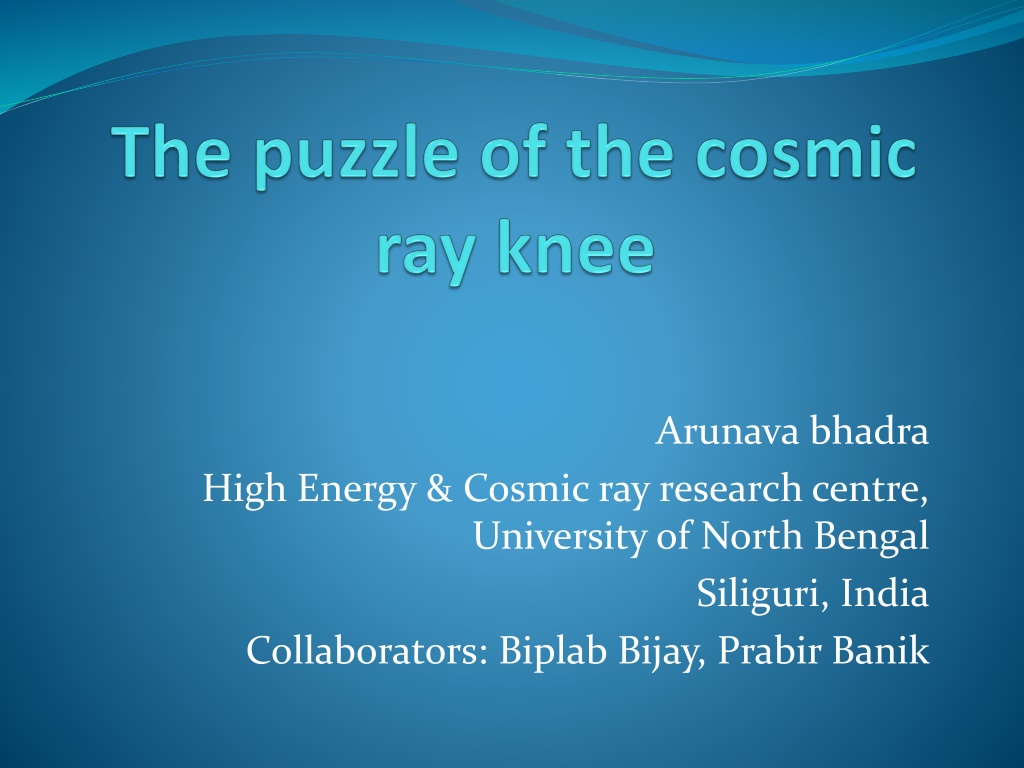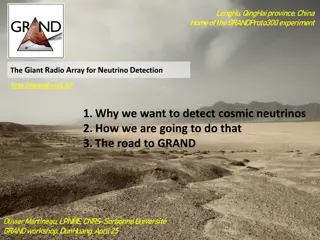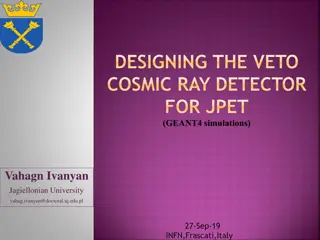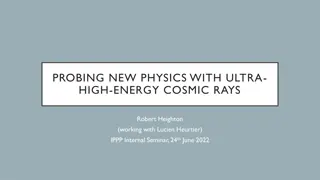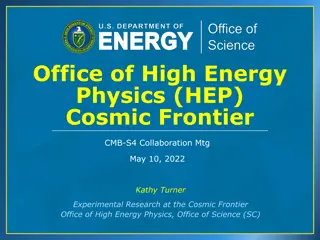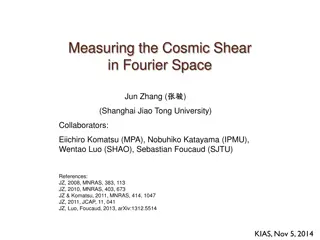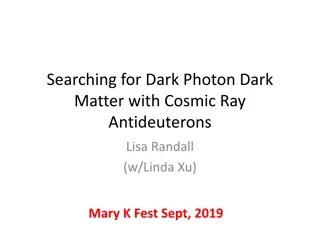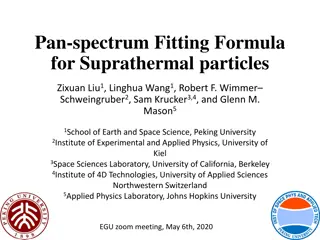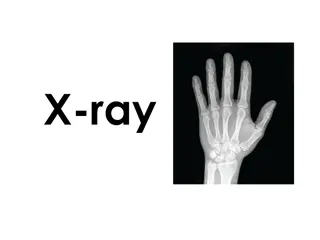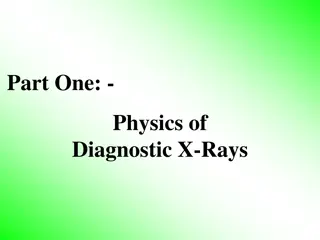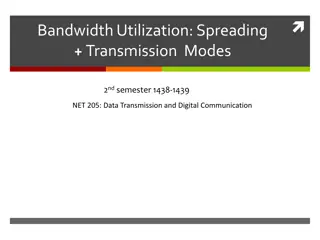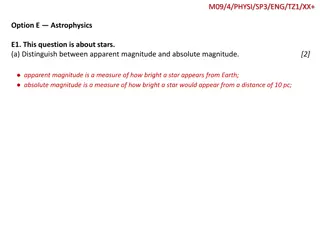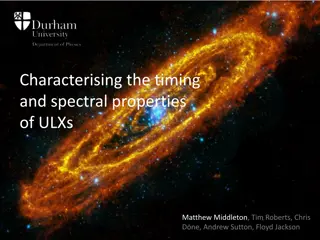Understanding Cosmic Ray Research: The Mysterious Knee in the Energy Spectrum
The energy spectrum of cosmic rays displays a unique power law behavior with distinct features such as the knee and the ankle. The knee, observed at around 3 PeV, marks a change in the spectral index. Various theories have been proposed to explain the origin of the knee, with suggestions ranging from galactic magnetic field inefficiency to shock acceleration in supernova remnants. This pivotal point in the energy spectrum provides crucial insights into the acceleration mechanisms and sources of cosmic rays. Collaboration and research efforts at the University of North Bengal and Bose Institute delve deep into unraveling the mysteries surrounding the cosmic ray knee.
Download Presentation

Please find below an Image/Link to download the presentation.
The content on the website is provided AS IS for your information and personal use only. It may not be sold, licensed, or shared on other websites without obtaining consent from the author. Download presentation by click this link. If you encounter any issues during the download, it is possible that the publisher has removed the file from their server.
E N D
Presentation Transcript
Arunava bhadra High Energy & Cosmic ray research centre, University of North Bengal Siliguri, India Collaborators: Biplab Bijay, Prabir Banik
The knee in the Energy spectrum Energy spectrum of all particle cosmic rays exhibits a power law behavior. There are few features in the spectrum out of which the knee and the ankle are prominent features. A slight bend of the spectrum at about 3 PeV, is known as the so called knee of the spectrum, where the power law spectral index changes from about -2.7 to nearly - 3.0. 18/12/2015 10th WAPP, Bose Institute Darjeeling
Energy spectrum 18/12/2015 10th WAPP, Bose Institute Darjeeling
Knee 2nd knee? Dip/Ankle GZK? s 140 GeV 2.5 TeV 20 TeV 100 TeV 450 TeV 18/12/2015 10th WAPP, Bose Institute Darjeeling
Origin of the knee The knee is an important imprint of the true model of origin of cosmic rays Several mechanisms have been proposed so far to explain the knee. an effect of the reduced efficiency of galactic magnetic field to confine the cosmic ray particles with energies above the knee within galaxy [Ginzburg and Syrovatskii, 1964, The Origin of Cosmic Rays, Macmillan, NewYork] the observed knee is the proton knee as per this model 18/12/2015 10th WAPP, Bose Institute Darjeeling
Contd. Due to acceleration mechanism [Fichtel and Linsley(1986), Jokipii(1986), Berezhko(1999), Stanev et al(1993) etc,] Among the galactic sources supernova remnants (SNRs) satisfy the energy budget of cosmic rays. cosmic rays are most probably energized by diffusive shock acceleration. The maximum energy that a charged particle can gain by diffusive shock acceleration is proportional to Z. Biermann(1993), 18/12/2015 10th WAPP, Bose Institute Darjeeling
Contd. The knee corresponds to the maximum energy that protons can have under diffusive shock acceleration in SNRs. The knee is very sharp, the spectral slop changes rather abruptly at the knee position [Erlykin and Wolfendale, J.G (1997)] Single source of the knee (EW 1997, Bhadra, (2005), Erlykin etal (2011), Ter-Antonyan, PRD (2014)] a variety of supernovae [Sveshnikova Astron Lett (2004), Sveshnikova AA(2003)] 18/12/2015 10th WAPP, Bose Institute Darjeeling
Cont. Nuclear photo-disintegration at the sources [Hillas Ann. Rev. Astron. Astrophys. (1979), Karakula and Tkaczyk(1993), Candia et al(2002) etc]. Cannonball model [Dar and Plaga(1999), Plaga(2002), Dar(2005), De Rujula(2005)] masses of baryonic plasma (cannonballs), ejected ultra-relativistically in bipolar supernova explosions, are considered as universal sources of hadronic galactic cosmic rays. 18/12/2015 10th WAPP, Bose Institute Darjeeling
Contd. a change in the characteristics of high energy interactions [Nikolsky and Romachin, Physics of Atomic Nuclei (2000)] producing a new type of a heavy particle unseen by air shower experiments, or an abrupt increase in the multiplicity of produced particles Ruled out by the LHC 18/12/2015 10th WAPP, Bose Institute Darjeeling
Mass distribution of progenitor of cosmic ray sources (Biplab Bijay and Bhadra, RAA, 2015) Particles are accelerated by expanding shock waves up to a maximum energy Emax. Emax is not the same for all the sources but differs depending on the explosion energy. The explosion energy in NS formation process is more or less constant (since the maximum mass of white dwarf/neutron star is restricted to ~1.4 M . In the case of BH formation process the explosion energy may differ considerably depending on final BH mass. 18/12/2015 10th WAPP, Bose Institute Darjeeling
In the gravitational collapse of a spherical mass distribution of rest mass M leading to formation of black hole, the maximum energy of extraction out of the collapse will be [Ruffini and Vitagliano(2003), Christodoulou and Ruffini(1971)]. Instead of collapse and resulting explosion, large amount of energy also can be released through accretion process. The Eddington luminosity limit, the maximum steady- state luminosity that can be produced is proportional to mass (M) of the central black hole. 18/12/2015 10th WAPP, Bose Institute Darjeeling
the zero age main sequence (ZAMS) stars mass spectrum also exhibits power law behavior [Salpeter. APJ, 1955] Using the expression for explosion energy as function of progenitor mass, we convolve the resulting explosion energy-progenitor mass relation with the initial mass function of the progenitors to obtain explosion energy distribution. N(> ) ~ -1.35. Finally using the relation of maximum energy that a cosmic ray particle may attain in shock acceleration process with explosion energy, the maximum energy distribution for main cosmic ray sources is derived. 18/12/2015 10th WAPP, Bose Institute Darjeeling
Problems with the model of the knee Standard SNR model/Leakage - There should a Fe knee around 100 PeV. Hence a special variety of supernovae or some other type of galactic or extra-galactic source has to be invoked as generator of cosmic rays between 100 PeV and the ankle. it requires fine-tuning to match both the flux and the energy at the point of taking over. There are other problems such as lower than expected observed gamma ray fluxes from SNRs (Bhadra J. Phys G 2002). 18/12/2015 10th WAPP, Bose Institute Darjeeling
Contd. Other models Fine tuning Mass composition The dilemma of the knee thus still continues. 18/12/2015 10th WAPP, Bose Institute Darjeeling
How the knee has been detected Detection of cosmic rays at very high energies Extensive Air Showers (EAS) EAS observables: Electron (shower) size, muon size, arrival direction, slope of lateral (radial) charge density, longitudinal development profile 18/12/2015 10th WAPP, Bose Institute Darjeeling
Shower size spectrum 18/12/2015 10th WAPP, Bose Institute Darjeeling
PRIMARY ENERGY SPECTRUM FROM EAS SHOWER SIZE SPECTRUM The observational charged particle size (often known as shower size) spectrum in EAS is found to exhibit power law behaviour The energy dependence of total number electrons, muons and hadrons at shower maximum in EAS initiated by a nucleus with atomic mass number A and energy Eo i stands for electron, muon, hadron 18/12/2015 10th WAPP, Bose Institute Darjeeling
For pure em cascade and under few simple approximations such as the all electrons have the same energy (which is the critical energy (85 MeV in air), at which ionization losses and radiative losses are equal) e is nearly equal to 1 (Matthews, Astropart. Phys. (2005), Hoerandel, Mod.Phys.Lett.A (2007). If one considers that total primary cosmic ray energy is distributed between electron and muon component, e will be slightly higher, about 1.05. Similarly when all muons are considered to have the same energy (which is the energy at which the probability for a charged pion to decay and to interact are equal) and taking the charged pion production multiplicity is 10 (constant), ~ 0.85. 18/12/2015 10th WAPP, Bose Institute Darjeeling
Two important points to be noted are (i) the total number of electrons increases with energy slightly faster than exactly linear whereas the total number of muons grows with energy slightly less than exactly linear. (ii) The electron number decreases with increasing mass number whereas muon number grows with mass number. One can infer the primary cosmic ray spectrum 18/12/2015 10th WAPP, Bose Institute Darjeeling
Since a sudden change in e at a size corresponding to a primary energy of about 3 PeV is observed, consequently a change in at 3 PeV is inferred which is the so called knee of the cosmic ray energy spectrum. Muon and hadron size spectra also should exhibit power law behaviour. Since < e ,for a change in one expects > e . Observationally, however, no significant change in is found ! 18/12/2015 10th WAPP, Bose Institute Darjeeling
On this ground Stenkin [Mod. Phys Letts. 2004, Nucl Phys B 2006] refuted the reality of the knee in the primary cosmic ray energy spectrum. 18/12/2015 10th WAPP, Bose Institute Darjeeling
Aim of the present work We shall examine from a detailed Monte Carlo simulation study whether observables suggest for consistent spectral indices in the primary cosmic ray energy spectrum before and after the knee considering the fact that primary composition may or may not change across the knee. the different EAS We use CORSIKA simulation code to have the relation between energy and shower size. 18/12/2015 10th WAPP, Bose Institute Darjeeling
Simulation procedure adopted The HE interaction model: QGSJET 01 (version 1c) /EPOS (version 2.1) The Low Energy interaction model UrQMD The US-standard atmospheric model with planar approximation The events are generated at EAS-TOP and KASCADE locations. The magnetic fields, observation levels, threshold energies of particle detection and zenith angles are provided accordingly. 18/12/2015 10th WAPP, Bose Institute Darjeeling
Inferring Primary cosmic ray spectrum from measured EAS size spectra Only a few EAS experiments so far measured both e and before and after the knee. Here we consider the results of two experiments, the KASCADE (Antoni et. al, Astropart. Phys. (2002) and EAS-TOP (Navarra et al, Nucl. Phys. B (1998). The KASCADE experiment Site - Forschungszentrum Karlsruhe (Germeny) altitude 110 m above sea level (49.1o N, 8.4o E), energy range ~100 TeV to nearly 100 PeV in operation during October 1996 to 2003. 18/12/2015 10th WAPP, Bose Institute Darjeeling
Contd. detectors an array of electron spread over 700 m 700 m. Muon detector a central hadron calorimeter The EAS-TOP experiment Location - Campo Imperatore, National Gran Sasso Laboratories in Italy, Altitude - 2005 m a.s.l. Detectors - electromagnetic, muon, hadron and atmospheric Cherenkov light 18/12/2015 10th WAPP, Bose Institute Darjeeling
18/12/2015 10th WAPP, Bose Institute Darjeeling
Energy KASCADE location from the Monte Carlo simulation data for p primary dependence of total charged particles at 18/12/2015 10th WAPP, Bose Institute Darjeeling
Energy dependence of truncated muon number for p primary 18/12/2015 10th WAPP, Bose Institute Darjeeling
18/12/2015 10th WAPP, Bose Institute Darjeeling
18/12/2015 10th WAPP, Bose Institute Darjeeling
Electron and muon spectra for astrophysical knee We shall follow a reverse process, we shall estimate the expected spectral slopes in charged particle and muon spectra for different primary composition scenario assuming that the primary energy spectrum has a knee. 18/12/2015 10th WAPP, Bose Institute Darjeeling
Expected electron size spectrum for unchanged proton primary 18/12/2015 10th WAPP, Bose Institute Darjeeling
Expected electron size spectrum for unchanged Fe primary 18/12/2015 10th WAPP, Bose Institute Darjeeling
Muon size spectrum for unchanged p primary 18/12/2015 10th WAPP, Bose Institute Darjeeling
Muon size spectrum for unchanged Fe primary 18/12/2015 10th WAPP, Bose Institute Darjeeling
Electron size spectrum when primary changes from p to Fe across the knee 18/12/2015 10th WAPP, Bose Institute Darjeeling
Muon size spectrum when primary changes from p to Fe across the knee 18/12/2015 10th WAPP, Bose Institute Darjeeling
2-dimensional electron size muon size spectrum for unchanged p primary 18/12/2015 10th WAPP, Bose Institute Darjeeling
18/12/2015 10th WAPP, Bose Institute Darjeeling
18/12/2015 10th WAPP, Bose Institute Darjeeling
18/12/2015 10th WAPP, Bose Institute Darjeeling
Conclusion The EAS-TOP observations on total charged particle and muon spectra consistently infer a knee in the primary energy spectrum provided the primary is pure unchanging iron. No consistent primary spectrum emerges from simultaneous use of the KASCADE observed total charged particle and muon spectra. For pure unchanging proton or iron primaries the difference in spectral slopes below and above the knee of the size spectrum is larger for muon spectrum than the electron spectrum. 18/12/2015 10th WAPP, Bose Institute Darjeeling
The prominent knee in the electron size spectrum but not in the muon size spectrum is really puzzling. When mass composition changes across the knee the situation becomes quite complex. In such a situation estimation of spectral index properly is challenging, particularly for total charged particle spectrum. the position of the knee depend on primary composition both below and above the knee of the primary energy spectrum the points close to the knee in the size spectra may change the overall slope considerably. 18/12/2015 10th WAPP, Bose Institute Darjeeling
The simultaneous use of the measured EAS total charged particle and muon size spectra to infer the primary energy spectrum is certainly a desirable approach but it requires a careful and experiment specific analysis. The two-dimensional differential spectrum contents substantially higher information than those of two one-dimensional ones but one dimensional spectra also carry important and exclusive signatures about primary energy spectrum and composition. Independent measurement of muon size spectrum is also very important . Looking for GRAPES 18/12/2015 10th WAPP, Bose Institute Darjeeling
Thank you 18/12/2015 10th WAPP, Bose Institute Darjeeling
Origin of cosmic rays The problem of cosmic ray origin Where they come from one of the most enduring mysteries in physics Being charged particles Cosmic Rays are deflected by the galactic magnetic field and as a result their direction does not point towards their origin 18/12/2015 10th WAPP, Bose Institute Darjeeling
Power requirement of Cosmic Ray sources If cosmic rays with the same energy density are also spread over the extra-galactic space, it will be too high for sources to meet such a huge power requirement. the power required to supply all the galactic cosmic rays is ~ 5 1040 erg /sec. 18/12/2015 10th WAPP, Bose Institute Darjeeling
An associated and relevant question :How they are produced or more specifically how they are accelerated to such high energies (the energy of the observed cosmic ray particles at the upper end of the energy spectrum is nearly 100,000,000 times higher than the maximum energy achieved in human made accelerators) The so called problem of acceleration mechanism 18/12/2015 10th WAPP, Bose Institute Darjeeling
Some Important characteristics of cosmic rays Isotropy Energy density Power law Energy spectrum Nuclear composition Isotropy - upper limit of amplitude of anisotropy upto the knee region is around 10-3 or even less isotropized by the galactic magnetic fields 18/12/2015 10th WAPP, Bose Institute Darjeeling
Energy density Energy density ~1 eV/cm3 (of the same order of the interstellar magnetic field and CMBR) the total cosmic ray energy density in the galaxy is ~ 4 1054 erg. 18/12/2015 10th WAPP, Bose Institute Darjeeling
